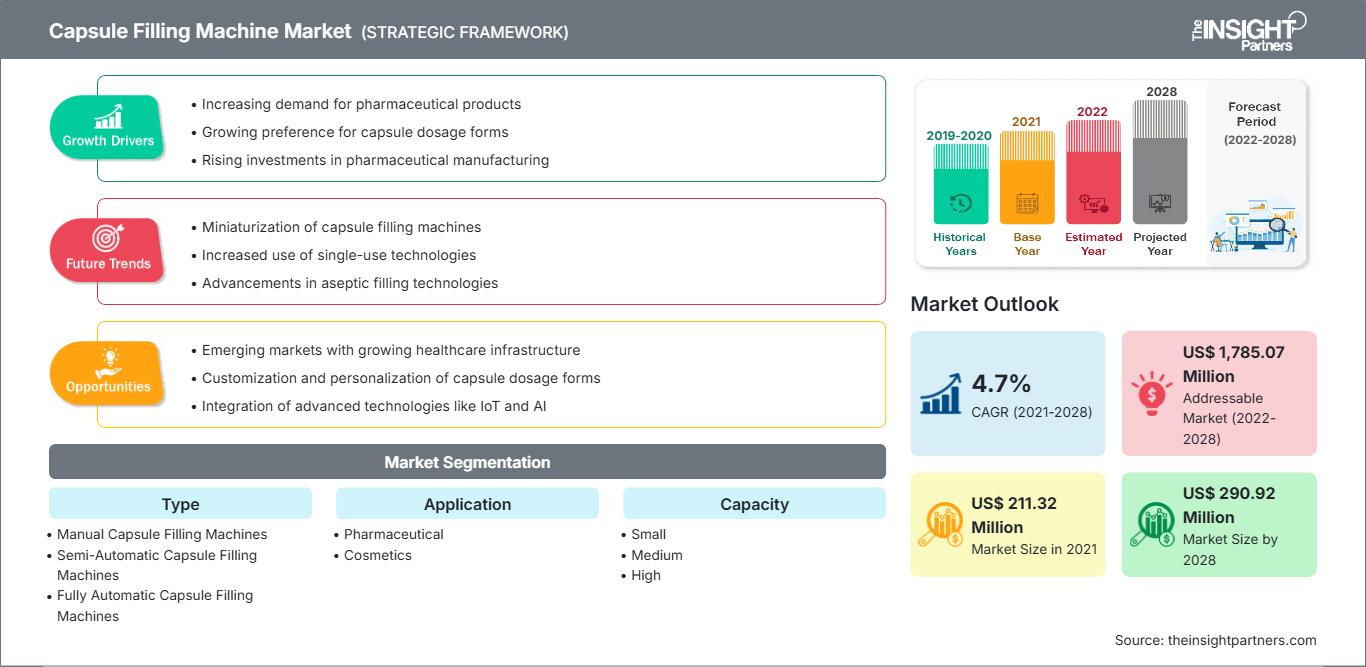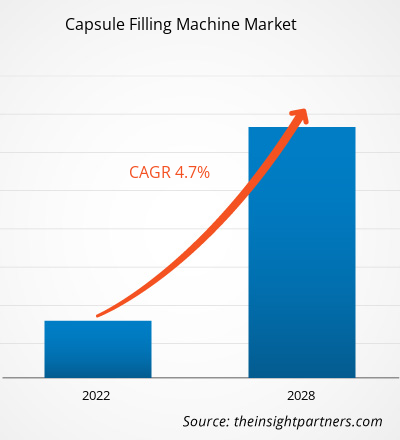[Informe de investigación] Se proyecta que el mercado de máquinas de llenado de cápsulas alcance los US$ 290,92 millones para 2028 desde los US$ 211,32 millones en 2021; se espera que crezca a una CAGR del 4,7% durante 2021 a 2028.
Las máquinas de llenado de cápsulas, también conocidas como máquinas de encapsulado, son dispositivos mecánicos ampliamente utilizados en la industria farmacéutica. Estas máquinas llenan cápsulas vacías de gelatina blanda o dura de diversos tamaños con polvos, gránulos, semisólidos o líquidos que contienen principios activos farmacéuticos o una combinación de estos y excipientes. Estas máquinas se utilizan en una amplia gama de industrias, como la química, la farmacéutica, la de alimentos para animales y la de alimentos y bebidas. Existen alrededor de 1600 instalaciones en todo el mundo para diversos tipos de llenadoras de cápsulas.
El crecimiento del mercado de máquinas encapsuladoras se atribuye a los avances en este sector y a la creciente prevalencia de enfermedades crónicas. Sin embargo, el alto costo de producción de estas máquinas dificulta su crecimiento.
Personalice este informe según sus necesidades
Obtendrá personalización en cualquier informe, sin cargo, incluidas partes de este informe o análisis a nivel de país, paquete de datos de Excel, así como también grandes ofertas y descuentos para empresas emergentes y universidades.
Mercado de máquinas de llenado de cápsulas: Perspectivas estratégicas

-
Obtenga las principales tendencias clave del mercado de este informe.Esta muestra GRATUITA incluirá análisis de datos, desde tendencias del mercado hasta estimaciones y pronósticos.
Perspectivas del mercado:
La creciente prevalencia de enfermedades crónicas impulsa el mercado de máquinas de llenado de cápsulas.
La creciente prevalencia de enfermedades crónicas, como las enfermedades cardiovasculares (ECV), el cáncer, la diabetes, los accidentes cerebrovasculares y las enfermedades renales, ha incrementado la demanda de máquinas de llenado de cápsulas para facilitar la producción de cápsulas medicinales. Según la OMS, las enfermedades cardiovasculares son la principal causa de muerte en todo el mundo, con 17,9 millones de muertes al año. Además, la creciente prevalencia de la diabetes ha incrementado la necesidad de cápsulas medicinales, impulsando la creciente demanda de máquinas de llenado de cápsulas. Según la novena edición del Atlas de la Diabetes de la Federación Internacional de Diabetes, alrededor de 463 millones de adultos (de 20 a 79 años) padecían diabetes en 2019, y se prevé que la cifra alcance los 700 millones para 2045. La creciente prevalencia del cáncer también está impulsando la demanda de máquinas de llenado de cápsulas. Según la OMS, el cáncer ha sido la segunda causa de muerte en todo el mundo, con 9,6 millones de muertes en 2018. El aumento de los casos de enfermedades renales crónicas a nivel mundial también ha incrementado la necesidad de medicamentos de uso diario, lo que se refleja en el crecimiento del mercado. El Instituto Nacional de Diabetes y Enfermedades Digestivas y Renales (NIDRN) declaró en un informe que más de 661,000 estadounidenses sufrieron insuficiencia renal en 2018, de los cuales 468,000 requirieron diálisis y medicación diaria. Debido a la creciente frecuencia de enfermedades crónicas e infecciones, la demanda de productos farmacéuticos está experimentando un rápido aumento, lo que subraya la importancia de las máquinas de llenado de cápsulas.
Perspectivas basadas en tipos
El mercado de máquinas de llenado de cápsulas, por tipo, se segmenta en máquinas de llenado de cápsulas manuales, máquinas de llenado de cápsulas semiautomáticas y máquinas de llenado de cápsulas totalmente automáticas. El segmento de máquinas de llenado de cápsulas totalmente automáticas tuvo la mayor participación de mercado en 2021. Además, se prevé que este mismo segmento registre la tasa de crecimiento anual compuesta (TCAC) más alta del mercado durante el período de pronóstico.
Perspectivas basadas en aplicaciones
Por aplicación, el mercado de máquinas de llenado de cápsulas se segmenta en los sectores farmacéutico, cosmético y otros. En 2021, el segmento farmacéutico tuvo la mayor participación de mercado. Además, se espera que este segmento registre su mayor crecimiento entre 2021 y 2028.
Perspectivas basadas en la capacidad
El mercado de máquinas de llenado de cápsulas, según su capacidad, se segmenta en pequeño (hasta 50.000 cápsulas), mediano (de 50.000 a 100.000 cápsulas por hora) y alto (más de 100.000 cápsulas por hora). En 2021, el segmento pequeño (hasta 50.000 cápsulas) tuvo la mayor participación de mercado. Además, se espera que este segmento registre la tasa de crecimiento anual compuesta (TCAC) más alta, del 5,0 %, entre 2021 y 2028.
El lanzamiento y la aprobación de productos son estrategias comunes que adoptan las empresas para expandir su presencia global y su portafolio de productos. Además, los actores del mercado de máquinas encapsuladoras se centran en la estrategia de asociación para ampliar su clientela, lo que, a su vez, les permite mantener su marca a nivel mundial.
Máquinas de llenado de cápsulas
Análisis regional del mercado de máquinas de llenado de cápsulas
Los analistas de The Insight Partners han explicado detalladamente las tendencias regionales y los factores que influyen en el mercado de máquinas de llenado de cápsulas durante el período de pronóstico. Esta sección también analiza los segmentos y la geografía del mercado de máquinas de llenado de cápsulas en América del Norte, Europa, Asia Pacífico, Oriente Medio y África, y América del Sur y Central.
Alcance del informe de mercado de máquinas de llenado de cápsulas
| Atributo del informe | Detalles |
|---|---|
| Tamaño del mercado en 2021 | US$ 211,32 millones |
| Tamaño del mercado en 2028 | US$ 290,92 millones |
| CAGR global (2021-2028) | 4,7% |
| Datos históricos | 2019-2020 |
| Período de pronóstico | 2022-2028 |
| Segmentos cubiertos |
Por tipo
|
| Regiones y países cubiertos |
América del norte
|
| Líderes del mercado y perfiles de empresas clave |
|
Densidad de actores del mercado de máquinas de llenado de cápsulas: comprensión de su impacto en la dinámica empresarial
El mercado de máquinas de llenado de cápsulas está creciendo rápidamente, impulsado por la creciente demanda del usuario final debido a factores como la evolución de las preferencias del consumidor, los avances tecnológicos y un mayor conocimiento de los beneficios del producto. A medida que aumenta la demanda, las empresas amplían su oferta, innovan para satisfacer las necesidades del consumidor y aprovechan las tendencias emergentes, lo que impulsa aún más el crecimiento del mercado.

- Obtenga una descripción general de los principales actores clave del mercado de máquinas de llenado de cápsulas
Perfiles de empresas
- ACG
- Capsugel, Inc. (una subsidiaria de Lonza Group AG)
- Tecnologías Schaefer
- Tecnología Syntegon GmbH
- Torpac Inc.
- Maquinaria Co. de Zhejiang Fuchang.
- Limitada; Beijing Hanlin Hangyu Technology Development Inc.
- M2G Srl;
- IMA Industria Macchine Automática SpA
- Análisis histórico (2 años), año base, pronóstico (7 años) con CAGR
- Análisis PEST y FODA
- Tamaño del mercado, valor/volumen: global, regional y nacional
- Industria y panorama competitivo
- Conjunto de datos de Excel
Informes recientes
Informes relacionados
Testimonios
Razón para comprar
- Toma de decisiones informada
- Comprensión de la dinámica del mercado
- Análisis competitivo
- Información sobre clientes
- Pronósticos del mercado
- Mitigación de riesgos
- Planificación estratégica
- Justificación de la inversión
- Identificación de mercados emergentes
- Mejora de las estrategias de marketing
- Impulso de la eficiencia operativa
- Alineación con las tendencias regulatorias






















 Obtenga una muestra gratuita para - Mercado de máquinas de llenado de cápsulas
Obtenga una muestra gratuita para - Mercado de máquinas de llenado de cápsulas